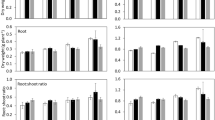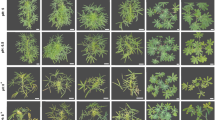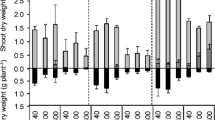Abstract
Aims
Cluster roots release carboxylic acids, especially citric acid, into the rhizosphere. We investigated how the citrate ion and the acidity interact to release phosphate.
Methods
We prepared solutions with differing citrate concentrations and differing pH and mixed these solutions with a soil. We investigated the effects of: pH, duration of mixing, the presence of chloroform, solution:soil ratio, and the effects of background electrolyte. We compared the results obtained with citrate with those obtained with arsenate.
Results
In the absence of chloroform, decomposition of citrate began after one hour. In the presence of chloroform it was delayed until after 24 hours. The higher the pH, the faster the decomposition. In the presence of chloroform, the ratio between phosphate and citrate in solution was steady between one and 24 hours. We chose a duration of six hours for further observations. Desorption of phosphate by citrate was most marked near pH 4. The peak in desorption was sharp in 0.01 M CaCl2 because, at high pH, much of the citrate was complexed with calcium. These effects of pH were modelled by assuming that divalent phosphate ions were displaced by divalent citrate ions. When compared with arsenate, citrate ions were better at dissolving surface iron atoms and thus releasing phosphate, but much worse in competing with phosphate ions in solution for sorption sites.
Conclusions
The acid component of citric acid has direct effects. It moves the pH into a region in which the HPO4− ion dominates and therefore facilitates uptake; it acts as a preservative thus slowing down citrate decomposition, and it directly increases desorption. However its most important effect occurs through interaction with citrate with greatest desorption near pH 4.










Similar content being viewed by others
References
Barrow NJ (1984) Modelling the effect of pH on phosphate sorption by soils. J Soil Sci 35:283–297
Barrow NJ (1999) The four laws of soil chemistry: the Leeper lecture 1998. Aust J Soil Res 37:787–829
Barrow NJ (2008) The description of sorption curves. Eur J Soil Sci 59:900–919
Barrow NJ (2017) The effects of pH on phosphate uptake from the soil. Plant Soil 410:401–410
Barrow NJ, Debnath A (2014) Effect of phosphate status on the sorption and desorption properties of some soils of northern India. Plant Soil 378:383–395
Barrow NJ, Cartes P, Mora ML (2005) Modifications to the Freundlich equation to describe anion sorption over a large range and to describe competition between pairs of anions. Eur J Soil Sci 56:601–606
Bowden JW, Posner AM, Quirk JP (1977) Ionic adsorption on on variable charge mineral surfaces. Theoretical-charge development and titration curves. Aust J Soil Res 15:121–126
Dickman SR, Cloutier AA (1951) Factors affecting the activity of aconitase. J BiolChem 188:379–388
Dinkelaker B, Romheld V, Marschner H (1989) Citric acid excretion and precipitation of calcium citrate in the rhizosphere of white lupin (Lupinus albus L). Plant Cell Environ 12:285–292
Gerke J (2015) The acquisition of phosphate by higher plants: effect of carboxylate release by the roots. A critical review. J Plant Nutr Soil Sci 178:351–364
Gerke J, Römer W, Jungk A (1994) The excretion of citric and malic acid by proteoide roots of Lupinus albus L; effects on soil solution concentration of phosphate, iron, and aluminium in the proteoid rhizosphere in samples of an oxisol and a luvisol. J Plant Nutr Soil Sci 157:289–294
Henintsoa M, Becquer T, Rabeharisoa L, Gerard F (2017) Geochemical and microbial controls of the effect of citrate on phosphorus availability in a ferralsol. Geoderma 291:33–39
Lambers H, Chapin FS, Pons TL (2008) Plant physiological ecology, Second edn. Springer-Verlag, New York
McLaren RG, Naidu R, Smith J, Tiller KG (1998) Fraction and distribution of arsenic in soils contaminated by cattle dip. J Environ Qual 27:384–394
Murphy J, Riley JP (1962) A modified single solution method for the determination of phosphate in natural waters. Anal Chim Acta 27:31–36
Oburger E, Leitner D, Jones DL, Zygalakis KG, Jaquier D, Roose T (2011) Adsorption and desorption dynamics of citric acid anions in soil. Eur J Soil Sci 62:733–742
Pate JS, Verboom WH, Galloway PD (2001) Co-occurrence of Proteaceae, laterite and related oligotrophic soils: coincidental associations or causative inter-relationships? Aust J Bot 49: 529–560
Price G (ed) (2006) Australian soil fertility manual. Fertilizer Industry Federation of Australia and CSIRO, 3rd edn. Blackwell-Synergy, Oxford, p 45
Shaff JE, Schultz BA, Craft JC, Clark RT, Kochian LV (2010) GEOCHEM-EZ: a chemical speciation program with greater power and flexibility. Plant Soil 330:207–214
Author information
Authors and Affiliations
Corresponding author
Additional information
Responsible Editor: Hans Lambers.
Rights and permissions
About this article
Cite this article
Barrow, N.J., Debnath, A. & Sen, A. Mechanisms by which citric acid increases phosphate availability. Plant Soil 423, 193–204 (2018). https://doi.org/10.1007/s11104-017-3490-8
Received:
Accepted:
Published:
Issue Date:
DOI: https://doi.org/10.1007/s11104-017-3490-8




